November 5, 2020, by Kathryn Steenson
The Art of Making Fireworks: a children’s guide
As we go into a second national lockdown and organised Bonfire Night displays across the country have been cancelled, I decided to have a look through the archives for any pretty images of fireworks or happy recollections of past celebrations. It was going to be light-hearted and cheerful post, but the collections here never fail to throw up disturbing and terrifying items, so instead this post is going dive into the world of the ever-popular children’s craft activity: domestic firework manufacture.
We start with G W Mortimer’s ‘Manual of Pyrotechny‘ (1824) [Ref: Special Collection TP300 MOR], a book intended to be ‘a useful assistant to those who are fond of a rational and scientific amusement’. He laments that no decent works on the subject have been published since 1760, seemingly bewildered that not everyone considers ‘amateur enthusiasm for explosives’ and ‘having all their fingers’ to be compatible hobbies.
The instructions are comprehensive and complicated, but Mortimer reassures the reader that the ingredients are easy to source. Nitre (or salt-peter, potassium nitrate) was available from most grocers, but had to be purified to improve the explosiveness and brilliancy of the fireworks. If the recent panic-buying has stripped the shelves of your local supermarket bare, damaged gunpowder can sometimes be procured cheaply instead, he tells us, and the nitre easily extracted with hot water.
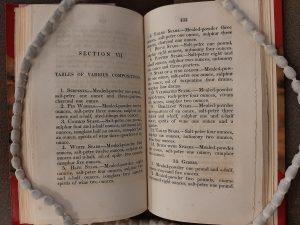
Rockets, gerbes, Roman candles, crackers…so many different fireworks, so many chances for something to go horribly wrong.
The method for purifying sulphur is less simple, and involve melting it in an iron pan, pouring it into a copper kettle (he doesn’t say whether the pans can be used for food preparation afterwards, but I shouldn’t chance it), and finally pouring it into wooden moulds. Woe betide anyone who didn’t read the instructions all the way through before starting their smelting, because the only safety advice comes at the end: ‘if the sulphur should take fire during this operation it may be quickly extinguished by covering the pan close over at the top’. How very reassuring.
The second book, The boy’s own book : a complete encyclopædia of all the diversions, athletic, scientific, and recreative of boyhood and youth (1829) [Ref: Briggs Collection LT210.GV /C5] made specific reference to Guy Fawkes. It very strongly advised against encouraging boys to make their own fireworks, wisely stating that it is ‘a dangerous operation in the hands of skilful persons, but infinitely more so when attempted by youth’. It goes on to recommend making paper fireworks, but the instructions are nearly as tedious as for the real thing, with less of a pay-off.
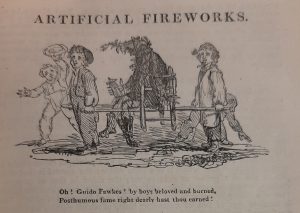
From ‘Boy’s Own Book’, which started off so well by recommending boys play with paper fireworks over the real thing.
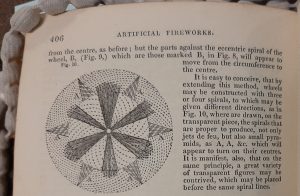
From ‘Boy’s Own Book’, which ended with these poorly-explained instructions allegedly written for children.
Reason initially prevailed in the third book too, which also mentioned paper fireworks, and began to think Mr Mortimer was an outlier, but no, it rapidly got worse. ‘Endless Amusements‘ (1834) [Ref: Briggs Collection LT210.Q /E6] included ‘the Art of Making Fireworks…so clearly explained as to be within the reach of even the most limited capacity’. Even if parents felt their child lacked even the minimum capacity required for fireworks, with 400 entertaining science experiments to choose from, they could always encourage their child to play with electricity instead. The explanations for making fireworks from gunpowder seemed fairly standard, and followed much the same recipes and pattern as the first book. The layout is clearer and there were some helpful tips to include benjamin (benzoin) for its pleasant aroma, presumably to counteract all that sulphur – also known as brimstone – being used.
Then it began to take a decidedly militaristic tone. There were a few pages dedicated to aquatic fireworks, which were sure to impress the uninitiated. Then came a guide to making mortars. Often in books this old, there are words and phrases that have changed meaning, and just because one of the modern definitions refers to a device that launches explosive shells, that doesn’t necessarily mean this book was encouraging children to hurl explosives around for fun.
But that’s exactly what it is doing. In fact children were encouraged to use their new long-range weaponry skills to stage miniature naval battles with ‘four or five small ships, about two or three feet in length’. It’s a shame that today’s children would struggle to find an outlet for their violent tendencies in this way, as few homes in Nottingham come with their own lake, and I can’t see this being permitted at Highfields.
Of course, these books are also full of harmless activities and amusements, such as this one for making invisible ink by mixing vinegar with…lead? Oh good grief.
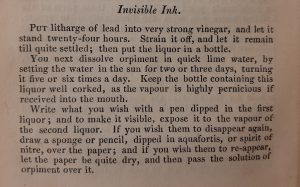
Keep your bottle corked, the vapour is ‘highly pernicious’. Or, alternatively, don’t let your children play with bottles of arsenic sulphide and quicklime.
These books are part of the Special Collections at Manuscripts & Special Collections at King’s Meadow Campus. Access to them is currently complicated by the coronavirus restrictions. You must book a study space in advance, which you can do by emailing us mss-library@nottingham.ac.uk. Please check our website and blog for the latest visiting information.
No comments yet, fill out a comment to be the first

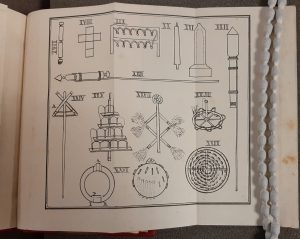
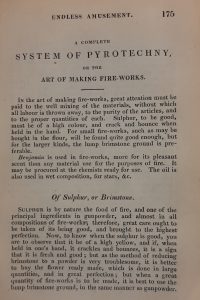
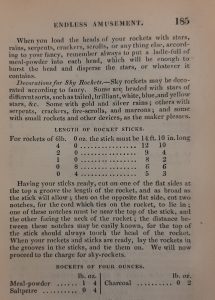
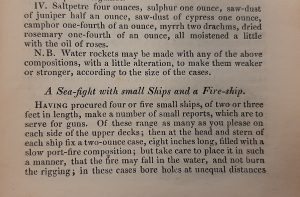
Leave a Reply